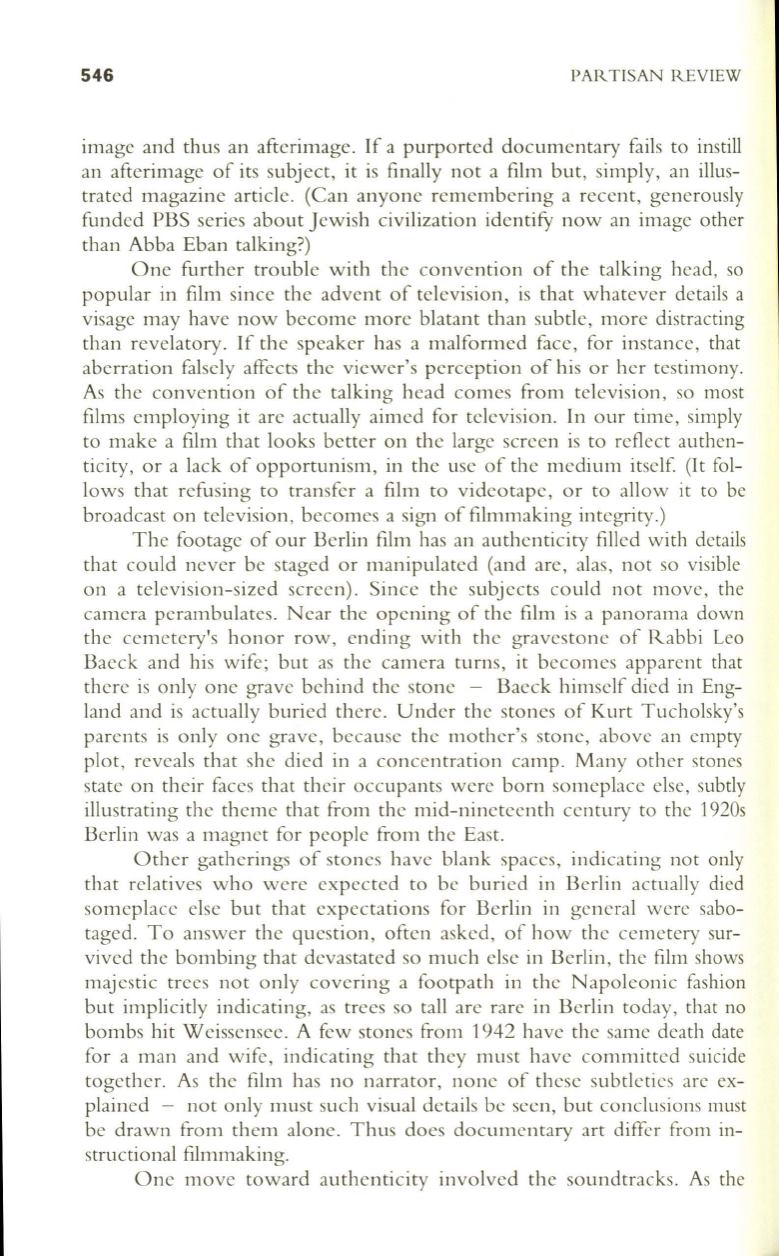
546
PARTISAN REVIEW
image and thus an afterimage.
If
a purported documentary fails to instill
an afterimage of its subject, it is finally not a film but, simply, an illus–
trated magazine article. (Can anyone remembering a recent, generously
funded PBS series about Jewish civilization identifY now an image other
than Abba Eban talking?)
One further trouble with the convention of the talking head, so
popular in film since the advent of television, is that whatever details a
visage may have now become more blatant than subtle, more distracting
than revelatory. If the speaker has a malformed face, for instance, that
aberration falsely affects the viewer's perception of his or her testimony.
As the convention of the talking head comes from television , so most
films employing it are actually aimed for television. In our time, simply
to make a film that looks better on the large screen is to reflect authen–
ticity, or a lack of opportunism, in the use of the medium itself. (It fol–
lows that refusing to transfer a film to videotape, or to allow it
to
be
broadcast on television, becomes a sign of filmmaking integrity .)
The footage of our Berlin film has an authenticity filled with details
that could never be staged or manipulated (and are, alas, not so visible
on a television-sized screen). Since the subjects could not move, the
camera perambulates. Near the opening of the film is a panorama down
the cemetery's honor row, ending with the gravestone of Rabbi Leo
Baeck and his wife; but as the camera turns, it becomes apparent that
there is only one grave behind the stone - Baeck himself died in Eng–
land and is actually buried there. Under the stones of Kurt Tucholsky's
parents is only one grave, because the mother's stone, above an empty
plot, reveals that she died in a concentration camp. Many other stones
state on their faces that their occupants were born someplace else, subtly
illustrating the theme that from the mid-nineteenth century to the 1920s
Berlin was a magnet for people from the East.
Other gatherings of stones have blank spaces, indicating not only
that relatives who were expected to be buried in Berlin actually died
someplace else but that expectations for Berlin in general were sabo–
taged. To answer the question, often asked , of how the cemetery sur–
vived the bombing that devastated so much else in Berlin , the film shows
majestic trees not only covering a footpath in the Napoleonic fashion
but implicitly indicating, as trees so tall are rare in Berlin today, that no
bombs hit Weissensee. A few stones from 1942 have the same death date
for a man and wife, indicating that they must have committed suicide
together. As the film has no narrator, none of these subtleties are ex–
plained - not only must such visual details be seen, but conclusions must
be drawn from them alone. Thus does documentary art differ from in–
structional filmmaking.
One move toward authenticity involved the soundtracks. As the


